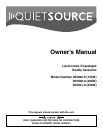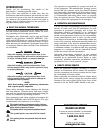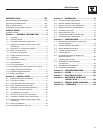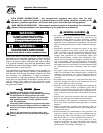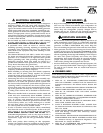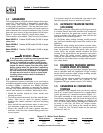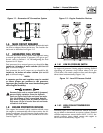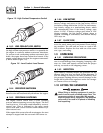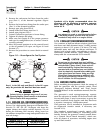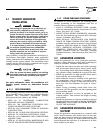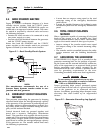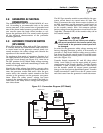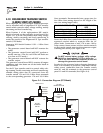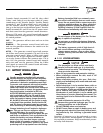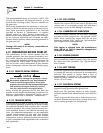
3
ELECTRICAL HAZARDS
• All generators covered by this manual produce dangerous
electrical voltages and can cause fatal electrical shock.
Utility power delivers extremely high and dangerous volt-
ages to the transfer switch as well as the standby generator.
Avoid contact with bare wires, terminals, connections, etc.,
on the generator as well as the transfer switch, if applicable.
Ensure all appropriate covers, guards and barriers are in
place before operating the generator. If work must be done
around an operating unit, stand on an insulated, dry surface
to reduce shock hazard.
• Do not handle any kind of electrical device while standing
in water, while barefoot, or while hands or feet are wet.
DANGEROUS ELECTRICAL SHOCK MAY RESULT.
• If personnel must stand on metal or concrete while
installing, operating, servicing, adjusting or repairing this
equipment, place insulative mats over a dry wooden plat-
form. Work on the equipment only while standing on such
insulative mats.
• The National Electrical Code (NEC), Article 250 requires
the frame and external electrically conductive parts of the
generator to be connected to an approved earth ground
and/or grounding rods. This grounding will help prevent
dangerous electrical shock that might be caused by a
ground fault condition in the generator set or by static elec-
tricity. Never disconnect the ground wire.
• Wire gauge sizes of electrical wiring, cables and cord sets
must be adequate to handle the maximum electrical current
(ampacity) to which they will be subjected.
• Before installing or servicing this (and related) equipment,
make sure that all power voltage supplies are positively
turned off at their source. Failure to do so will result in haz-
ardous and possibly fatal electrical shock.
• Connecting this unit to an electrical system normally sup-
plied by an electric utility shall be by means of a transfer
switch so as to isolate the generator electric system from
the electric utility distribution system when the generator is
operating. Failure to isolate the two electric system power
sources from each other by such means will result in dam-
age to the generator and may also result in injury or death
to utility power workers due to backfeed of electrical ener-
gy.
• Generators installed with an automatic transfer switch will
crank and start automatically when NORMAL (UTILITY)
source voltage is removed or is below an acceptable preset
level. To prevent such automatic start-up and possible
injury to personnel, disable the generator’s automatic start
circuit (battery cables, etc.) before working on or around
the unit. Then, place a “Do Not Operate” tag on the genera-
tor control panel and on the transfer switch.
• In case of accident caused by electric shock, immediately
shut down the source of electrical power. If this is not pos-
sible, attempt to free the victim from the live conductor.
AVOID DIRECT CONTACT WITH THE VICTIM. Use a
nonconducting implement, such as a dry rope or board, to
free the victim from the live conductor. If the victim is
unconscious, apply first aid and get immediate medical
help.
• Never wear jewelry when working on this equipment.
Jewelry can conduct electricity resulting in electric shock,
or may get caught in moving components causing injury.
FIRE HAZARDS
• Keep a fire extinguisher near the generator at all times. Do
NOT use any carbon tetra-chloride type extinguisher. Its
fumes are toxic, and the liquid can deteriorate wiring insu-
lation. Keep the extinguisher properly charged and be
familiar with its use. If there are any questions pertaining
to fire extinguishers, consult the local fire department.
EXPLOSION HA
ZARDS
• Do not smoke around the generator. Wipe up any fuel or oil
spills immediately. Ensure that no combustible materials
are left in the generator compartment, or on or near the
generator, as FIRE or EXPLOSION may result. Keep the
area surrounding the generator clean and free from debris.
• These generator sets may operate using one of several types
of fuels. All fuel types are potentially FLAMMABLE and/or
EXPLOSIVE and should be handled with care. Comply with
all laws regulating the storage and handling of fuels. Inspect
the unit’s fuel system frequently and correct any leaks
immediately. Fuel supply lines must be properly installed,
purged and leak tested according to applicable fuel-gas
codes before placing this equipment into service.
• Gaseous fluids such as natural gas and liquid propane (LP)
gas are extremely EXPLOSIVE. Natural gas is lighter than
air, and LP gas is heavier than air; install leak detectors
accordingly.
STANDARDS INDEX
In the absence of pertinent standards, codes, regulations and
laws, the published information listed below may be used as
installation guide for this equipment.
1. NFPA No. 37, STATIONARY COMBUSTION ENGINES
AND GAS TURBINES, available from the National Fire
Protection Association, 470 Atlantic Avenue, Boston, MA
02210.
2. NFPA No. 76A, ESSENTIAL ELECTRICAL SYSTEMS FOR
HEALTH CARE FACILITIES, available same as Item 1.
3. NFPA No. 54, NATIONAL FUEL GAS CODE, available
same as Item 1.
4. NFPA No. 58, AMERICAN NATIONAL STANDARD FOR
STORAGE AND HANDLING OF LIQUEFIED PETROLE-
UM GAS, available same as Item 1.
5. NFPA No. 70, NFPA HANDBOOK OF NATIONAL ELEC-
TRIC CODE, available same as Item 1.
6. Article X, NATIONAL BUILDING CODE, available from
the American Insurance Association, 85 John Street, New
York, N.Y. 10038.
7. AGRICULTURAL WIRING HANDBOOK, available from the
Food and Energy Council, 909 University Avenue,
Columbia, MO 65201.
8. ASAE EP-3634, INSTALLATION AND MAINTENANCE OF
FARM STANDBY ELECTRICAL SYSTEMS, available from
the American Society of Agricultural Engineers, 2950
Niles Road, St. Joseph, MI 49085.
9. NFPA No. 30, FLAMMABLE AND COMBUSTIBLE LIQ-
UIDS CODE, available same as Item 1.
Important Safety Instructions
Liquid-cooled 15, 20 and 25 kW Generators



